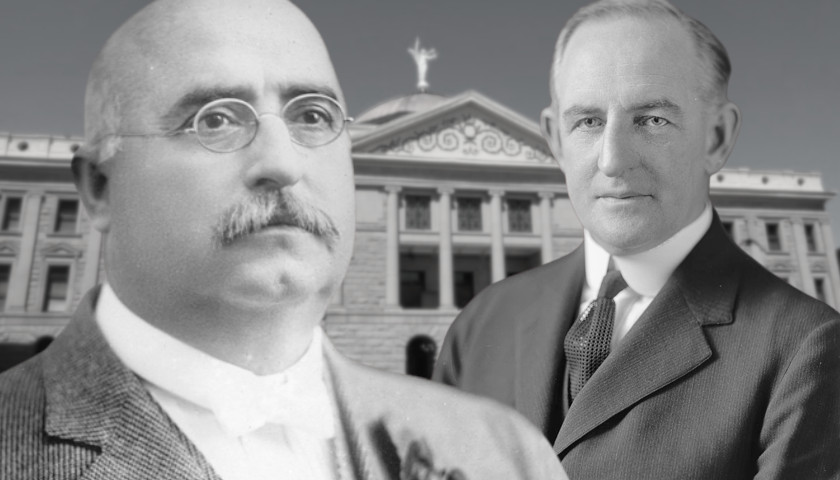As the protests and litigation continue in Arizona, challenging the results of the 2022 midterm election where four Trump-endorsed candidates lost, some are looking at history to understand how the litigation may end. In 1916, a contentious gubernatorial race in Arizona, also fraught with accusations of voter fraud, resulted in a clear winner not being established until the next year, when the Arizona Supreme Court declared the Democrat the winner.
Arizona historian and writer Donna Reiner relayed the story of that election for Arizona Agenda this fall, revealing how due to the feuding over who won, there were two governors both claiming to hold office for several months. It was Arizona’s third statewide election after becoming a state in 1912, and incumbent Gov. George Wiley Paul Hunt, a Democrat and Arizona’s first governor faced Republican challenger Thomas E. Campbell of Yavapai County.
Hunt was criticized for overspending, deficits, opposing the death penalty, and other issues. Arizona Oddities described him as “a man with an ego so large that he believed that as long as he lived the governor’s chair was his private domain;” and, “People either liked Hunt or hated him.” Inside Tucson Business described him as “colorful and uncouth” and said, “he liked to wear white suits that were usually stained with tobacco juice.”
Hunt maintained an “anti-business” image, “but the controversial governor’s political enemies countered: his back door was always open to big monied interests.” Arizona historian Marshall Trimble said that Hunt kept his front door open to the workers, but his backdoor was open to the mining companies. Additionally, “Supported by organized labor, he rewarded his friends with jobs.”
Republicans referred derisively to his network of supporters as the “Hunt Machine.” As chairman of Arizona’s Constitutional Convention, Hunt “refused to appoint any Republicans as chairmen of committees,” Inside Tucson Business stated. “He spent time in back rooms wheeling and dealing to get populist provisions into the constitution.”
While Hunt was an early supporter of women’s suffrage, he also pushed legislation prohibiting women from “loitering” in saloons.
In contrast, according to one historical article, “Tom Campbell was an immensely popular Arizonan, and his national political stature was demonstrated when his name was placed in nomination for U.S. vice president at the 1924 Republican National Convention.”
On Election Day, November 7, 1916, Campbell was declared the winner by 67 votes, 28,151 votes to Hunt’s 28,084 votes. But some more votes trickled in from counties, leading Hunt to claim victory by 146 votes, while Campbell also claimed victory by 300 votes. As more votes came in, Campbell’s alleged lead shrunk to 175 votes.
Hunt challenged the results in court, alleging that the ballots were counted improperly. Voters could mark a cross sign (+) on the ballot to vote for a straight Republican ticket or a straight Democratic ticket. But some Democratic voters chose to both insert a cross mark for the Democratic ticket and another mark by Campbell’s lead. Election officers generally rejected those ballots, but the counties applied them inconsistently. The courts held that the cross-sign party vote outweighed any extra votes from the voter for the other party’s candidate.
Campbell’s lead shrunk to 55 votes by November 23, 1916, as more votes came in. In early December, Hunt’s legal counsel demanded an examination of the ballots. Concerns arose that some of the ballots that were not counted had been discarded already.
Campbell was certified as governor on December 20, 1916, and sworn in on December 30, 1916. However, Hunt also swore himself in as governor and refused to leave the office. On January 2, 1917, Campbell asked the courts to declare him governor. On January 28, 1917, the Arizona Supreme Court declared Campbell, the governor.
Meanwhile, an examination of the ballots was taking place in the Superior Court, where there were accusations of fraud, corruption, and other irregularities, especially in Douglas. Campbell accused election officials there of fraud. His legal team contended, “By reason of misconduct on the part of the election board of precinct No. 1 in Douglas, Cochise county, Arizona, at said election, a large number of ballots that had been properly and duly marked by the voters who cast the same so as to indicate their intent to vote for contestee were fraudulently changed by members of said election board by the partial erasure of the marks placed thereon by said voters and by fraudulently placing other marks thereon and said ballots so fraudulently changed and marked by said election board were wrongfully counted for contestant, and the number of these were 123 or more.”
The inspection took five months and Superior Court Judge R.C. Stanford concluded that Campbell won by 30 to 67 votes.
Hunt filed a 300-page appeal with the Arizona Supreme Court. That court issued a test to determine voter intent, which remains precedent today. The court held in Hunt v. Campbell that a voter must “express his choice substantially in the manner provided by statute” for his vote to be counted. The judges used this to justify counting questionable votes for Hunt while rejecting questionable votes for Campbell, declaring Hunt the winner by 43 votes.
According to an article in the State Bar of Arizona’s Arizona Attorney, “On one ballot, the box next to Hunt’s name was marked ‘with just the faintest intersection of the lines.’ The court counted the ballot for Hunt because it manifested a bona fide effort by the voter to make a cross and mark it substantially in the square. By contrast, the court rejected a vote for Campbell on another ballot on which the voter had written the number ‘1’ inside the box next to Campbell’s name instead of a cross while at the same time marking ‘an excellent cross’ in the squares next to many other candidates on the same ballot.”
Although that ended the controversy, both men still served as governor. Campbell ran for governor again in 1918, but not against Hunt, and won. Hunt ran for governor in 1922 and defeated Campbell to secure a third term, serving five more himself.
– – –
Rachel Alexander is a reporter at The Arizona Sun Times and The Star News Network. Follow Rachel on Twitter. Email tips to [email protected].
Background Photo “Arizona Capitol” by Gage Skidmore. CC BY-SA 2.0.





